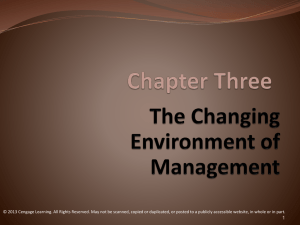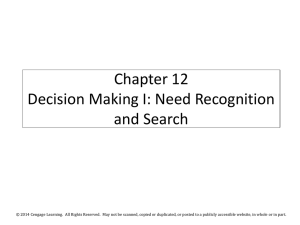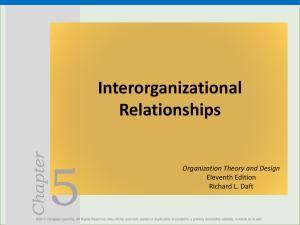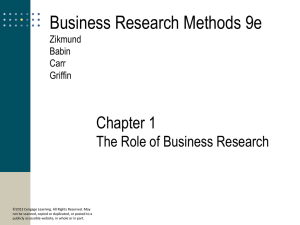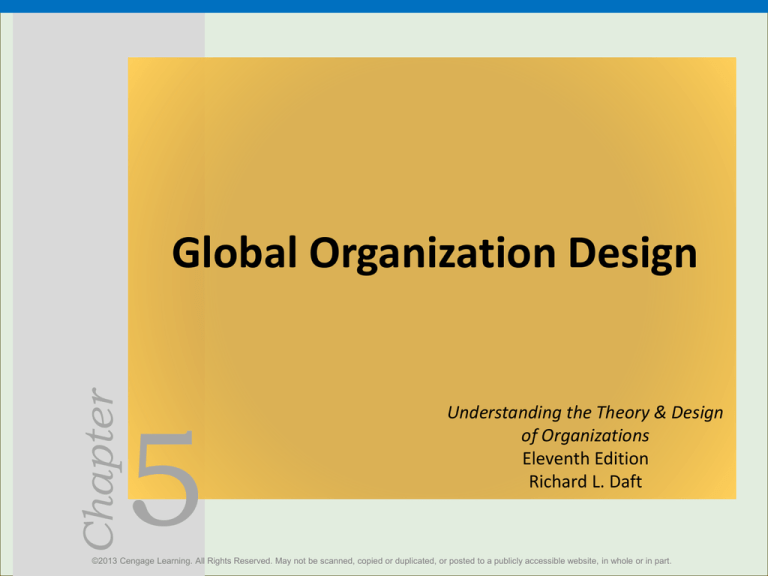
Chapter
Global Organization Design
5
Understanding the Theory & Design
of Organizations
Eleventh Edition
Richard L. Daft
©2013 Cengage Learning. All Rights Reserved. May not be scanned, copied or duplicated, or posted to a publicly accessible website, in whole or in part.
Entering The Global Arena
• More companies are doing business globally
• Companies need top leaders who have a
global outlook
• Advancements in technology and world
communications have changed the
competitive landscape
2
©2013 Cengage Learning. All Rights Reserved. May not be scanned, copied or duplicated, or posted to a publicly accessible website, in whole or in part.
Motivations for Global Expansion
Economic, technological, and competitive
forces have combined to push companies
from a domestic to a global focus
Motivations for Global Expansion:
• Economies of Scale
• Economies of Scope
• Low-Cost Production Factors
3
©2013 Cengage Learning. All Rights Reserved. May not be scanned, copied or duplicated, or posted to a publicly accessible website, in whole or in part.
The Global Economy as Reflected in
the Fortune Global 500
©2013 Cengage Learning. All Rights Reserved. May not be scanned, copied or duplicated, or posted to a publicly accessible website, in whole or in part.
Stages of International Evolution
5
©2013 Cengage Learning. All Rights Reserved. May not be scanned, copied or duplicated, or posted to a publicly accessible website, in whole or in part.
Global Expansion Through
International Strategic Alliance
• Licensing – allowing another firm to market
your brands
• Joint Ventures – separate entity of two or
more firms
• Consortia – groups of independent companies
6
©2013 Cengage Learning. All Rights Reserved. May not be scanned, copied or duplicated, or posted to a publicly accessible website, in whole or in part.
Strategies for Global vs.
Local Opportunities
• Global standardization versus local
responsiveness
– Globalization or multidomestic strategy
• Globalization strategy - products are
standardized throughout the world
• Multidomestic strategy - competition is
handled in each country independently
7
©2013 Cengage Learning. All Rights Reserved. May not be scanned, copied or duplicated, or posted to a publicly accessible website, in whole or in part.
Fitting Organization Structure to
International Advantages
©2013 Cengage Learning. All Rights Reserved. May not be scanned, copied or duplicated, or posted to a publicly accessible website, in whole or in part.
Global Organization Structure
International Division
Global Product Division
Global Geographic Division
Global Matrix Structure
9
©2013 Cengage Learning. All Rights Reserved. May not be scanned, copied or duplicated, or posted to a publicly accessible website, in whole or in part.
Domestic Hybrid Structure with
International Division
©2013 Cengage Learning. All Rights Reserved. May not be scanned, copied or duplicated, or posted to a publicly accessible website, in whole or in part.
Partial Global Product Structure
11
©2013 Cengage Learning. All Rights Reserved. May not be scanned, copied or duplicated, or posted to a publicly accessible website, in whole or in part.
Global Geographic Structure
©2013 Cengage Learning. All Rights Reserved. May not be scanned, copied or duplicated, or posted to a publicly accessible website, in whole or in part.
Global Matrix Structure
13
©2013 Cengage Learning. All Rights Reserved. May not be scanned, copied or duplicated, or posted to a publicly accessible website, in whole or in part.
The Global Organizational Challenge
©2013 Cengage Learning. All Rights Reserved. May not be scanned, copied or duplicated, or posted to a publicly accessible website, in whole or in part.
Leading Multinational Companies and
Selected Countries
15
©2013 Cengage Learning. All Rights Reserved. May not be scanned, copied or duplicated, or posted to a publicly accessible website, in whole or in part.
Examples of Trickle-Up Innovation
©2013 Cengage Learning. All Rights Reserved. May not be scanned, copied or duplicated, or posted to a publicly accessible website, in whole or in part.
Global Coordination Mechanisms
Global Teams
Headquarters Planning
Expanded
Coordination Roles
17
©2013 Cengage Learning. All Rights Reserved. May not be scanned, copied or duplicated, or posted to a publicly accessible website, in whole or in part.
Benefits of Collaboration
→ Cost Savings
→ Better Decision Making
→ Greater Revenue
→ Increased Innovation
18
©2013 Cengage Learning. All Rights Reserved. May not be scanned, copied or duplicated, or posted to a publicly accessible website, in whole or in part.
Cultural Differences In
Coordination and Control
National Value System
• Power Distance: people accept inequality
• Uncertainty Avoidance: members feel
uncomfortable with uncertainty and
ambiguity
19
©2013 Cengage Learning. All Rights Reserved. May not be scanned, copied or duplicated, or posted to a publicly accessible website, in whole or in part.
National Approaches to
Coordination and Control
1) Centralized Coordination: Japanese
Companies
2) Decentralized Approach: European Firms
3) Coordination and Control Through
Formalization: The United States
4) Tradition in Chinese companies remains
more family-oriented and relatively small
20
©2013 Cengage Learning. All Rights Reserved. May not be scanned, copied or duplicated, or posted to a publicly accessible website, in whole or in part.
The Transnational
Model of Organization
• Advanced international organization to deal with multiple,
interrelated, complex issues
• Theory is based on interdependence
• Useful for large, multinational companies with subsidiaries
• Create an integrated network of individual operations that are
linked together
• Not an organizational chart; it is a managerial state of mind
21
©2013 Cengage Learning. All Rights Reserved. May not be scanned, copied or duplicated, or posted to a publicly accessible website, in whole or in part.
International
Organizational
Units
©2013 Cengage Learning. All Rights Reserved. May not be scanned, copied or duplicated, or posted to a publicly accessible website, in whole or in part.
Transnational Organizations
• Assets and resources are dispersed worldwide
• Structures are flexible and ever-changing
• Subsidiary managers initiate strategy and
innovations that become strategy for the
whole organization
• Corporate culture, shared vision, and
management style guide the organization
23
©2013 Cengage Learning. All Rights Reserved. May not be scanned, copied or duplicated, or posted to a publicly accessible website, in whole or in part.
Design Elements
Managers must design organizations for complex international
coordination
Organizations’ international strategies and structures evolve
There are diverse options for specific international strategies
There are a variety of challenges for global organizations
Diverse national and cultural values influence an
organization’s approach
Companies operating globally require broad coordination
24
©2013 Cengage Learning. All Rights Reserved. May not be scanned, copied or duplicated, or posted to a publicly accessible website, in whole or in part.



